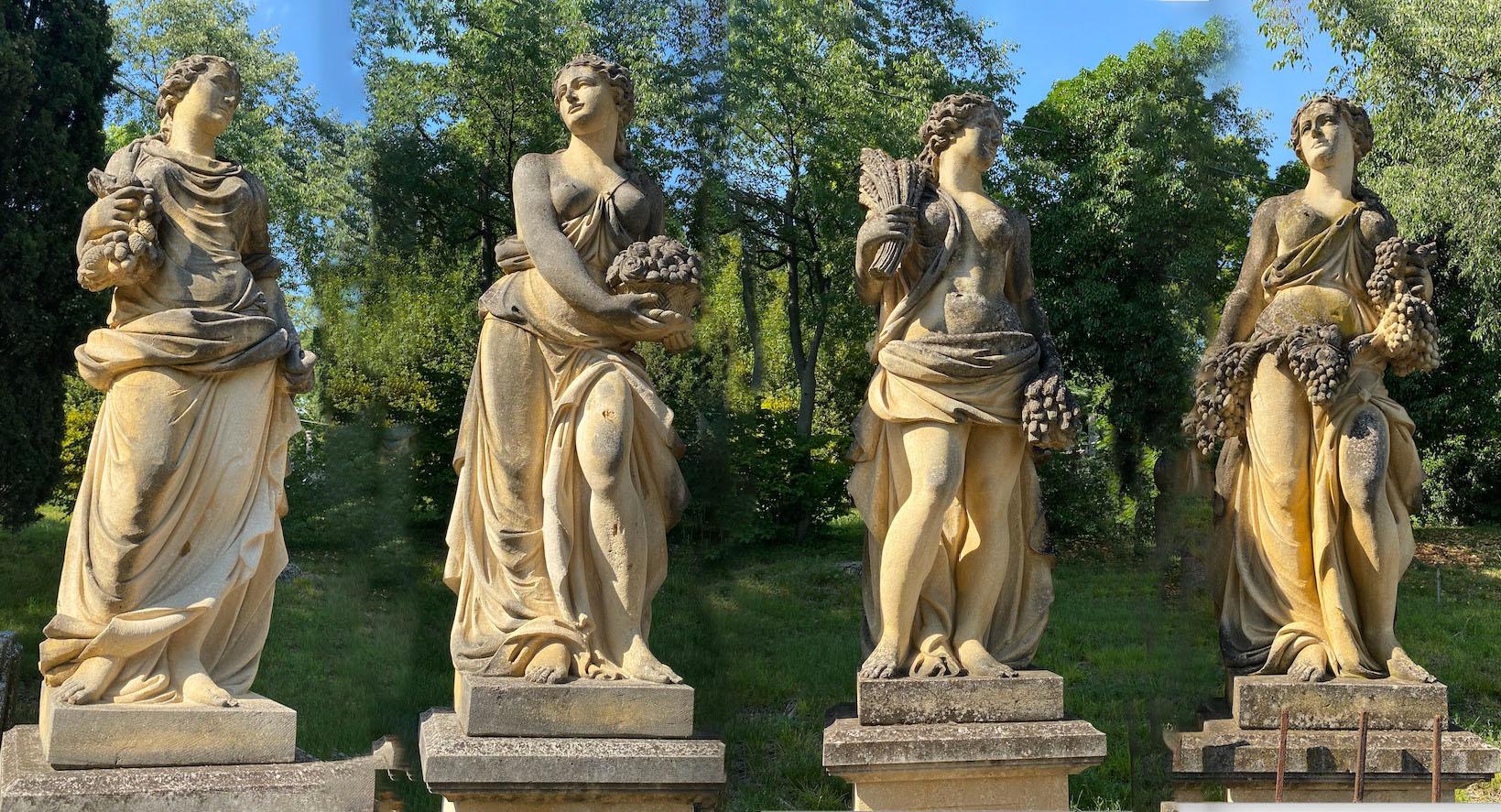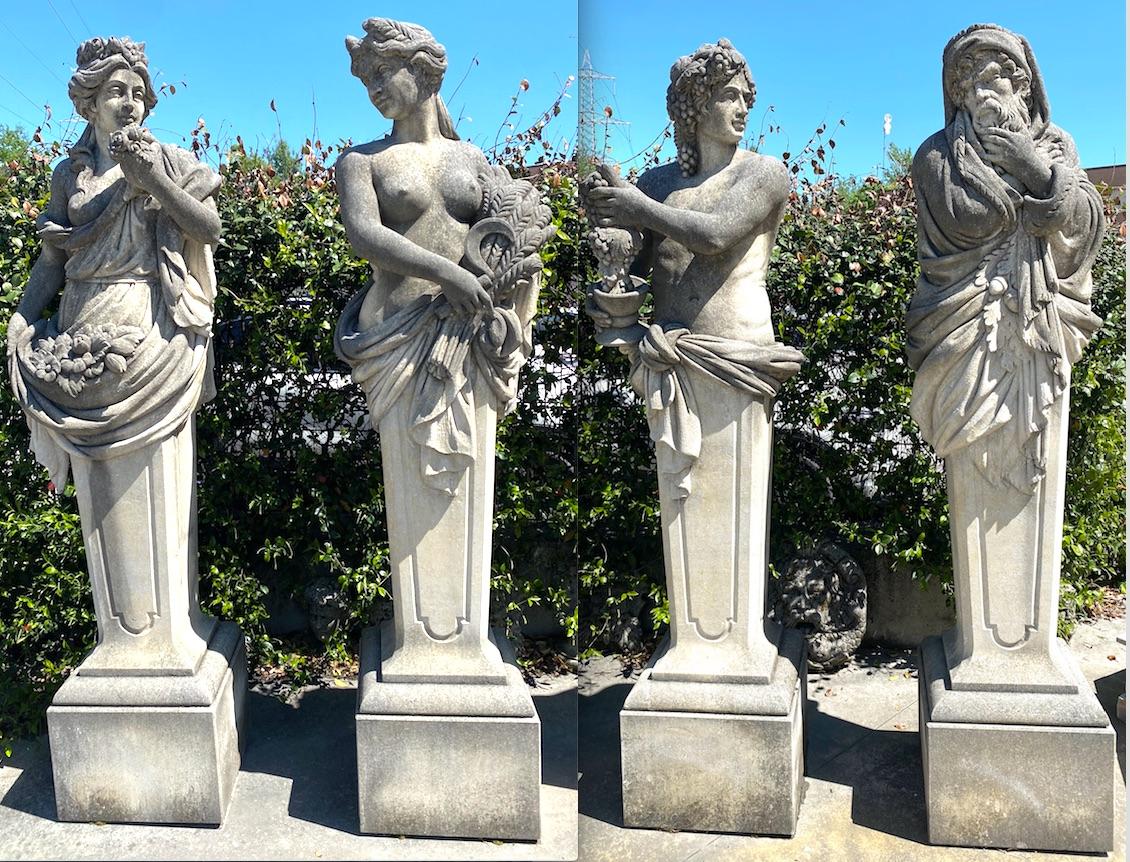Items Similar to Hl. Hieronymus
Want more images or videos?
Request additional images or videos from the seller
1 of 11
UnknownHl. Hieronymus1500/20
1500/20
About the Item
St. Jerome
347 Stridon, Croatia - 420 Bethlehem
Around 1500/20
Limestone
Remains of the original polychromy
Height 45 cm
The man with the holy name!
347 Stridon, Croation – 420 Bethlehem
Everyone knows St. Jerome, one of the most important church fathers of antiquity.
That Jerome means “Holy Name” and that he was one of the most prolific authors of Late Antiquity
was, is hardly known. His biography reads like an exciting narrative.
Jerome is one of the most captivating figures of Christian antiquity. He possessed an almost morbid sensibility, a loving and passionate heart, was jealous, suspicious, excitable, vindictive, and intemperate in his polemics. But he was also passionate in his love for the Church and in defense of Catholic truth. He united in himself the ascetic and the scholar. With Augustine, Jerome is the most learned of the Latin Church Fathers .
In addition to his grammatical and rhetorical education, Jerome possessed a knowledge of languages (Latin, Greek, Hebrew) that was unique for that time, as well as geographical, archaeological and literary knowledge. He had recognized the value of original texts and his achievement as a translator is extraordinary. His main merit for the Church remains the creation of the Vulgate (translation of the Bible). His influence on the culture of the Middle Ages was deep and lasting.
He is patron of:
Croatia, Dalmatia and Lyon,
of pupils, students, teachers, scholars, theologians, translators, proofreaders,
of the theological faculties, scientific associations, Bible societies and ascetics, against eye diseases
The representations of Jerome are still very much in demand today. Two-dimensional as a painting is this in the 15. and 16. to be found more often. As a three-dimensional sculpture rarer. This extraordinary sculpture of St. Hieronymus convinces with a high artistic quality. It was executed in limestone by a master craftsman. Remnants of polychromy are still present.
The condition is very good and according to the age museum. Such great works are special rarities today and hard to find.
- Creation Year:1500/20
- Dimensions:Height: 17.72 in (45 cm)Width: 7.88 in (20 cm)
- Medium:
- Period:
- Condition:
- Gallery Location:Wien, AT
- Reference Number:1stDibs: LU1143213902252
About the Seller
No Reviews Yet
Vetted Seller
These experienced sellers undergo a comprehensive evaluation by our team of in-house experts.
Established in 1986
1stDibs seller since 2019
Typical response time: 11 hours
- ShippingRetrieving quote...Ships From: Wien, Austria
- Return PolicyA return for this item may be initiated within 14 days of delivery.
More From This SellerView All
- Ancient DeityLocated in Wien, WienANCIENT DEITY Seated representation of God Southern Arabia Pre sabean 2nd - 1st millennium BC. Oolite limestone Height 24,5 cm Comparable works in the British Museum/London ...Category
15th Century and Earlier Figurative Sculptures
MaterialsLimestone
- Standing EngelLocated in Wien, WienStanding angel with banner Flemish Around 1450/60 Sandstone 60 x 21 x 15 cm This museum figurine shows a standing angel with a banner in his right hand and a small box in his left. The youthful, ageless figure wears a coat held together with a triangular, floral brooch in front of the chest over a long robe. The angel’s gaze is directed forward, his head tilted slightly to the left. The elongated face is sculpted: the large almond-shaped eyes with accentuated upper and lower eyelids are alertly open and sharp eyebrows lead directly into the root of the nose. The straight nose above the pronounced mouth completes the idealized oval face of the angel and his calm, internalized facial expression. What is particularly remarkable, however, is the magnificent curls, which are only partially tamed by a simple headband. As if puffed up by the wind, the hair, which is sometimes streaked in parallel, sometimes wildly twisted and richly curled, stands out dynamically from the ears. The tilted head with these sideways protruding waves of hair thus conveys an immediate impression of movement. The physicality of the sculpture is expressed particularly through this organic, lifelike movement of the loosened hair. The lively overall impression of the figure is further enhanced by the multiple rolled banners that the angel presents to the viewer. The outstretched palm of the right hand appears both intimate and confidential as well as mystically revealing. This banderole winds in gentle curves in front of the figure’s body, throws a fold over the second attribute in the angel’s left hand and falls downwards in a loose manner. The volute-shaped rolled up end of the banner clearly shows the fine texture of the banner and at the same time draws the viewer’s attention to the small cube-shaped box that the angel is holding in its slender, long-limbed fingers. The cube is decorated with a Gothic quatrefoil motif, which is often seen in the architectural tracery of windows, but was also often used to decorate caskets and other small treasures. The sweeping gestures in the presentation of the attributes suggest three-dimensionality, in contrast to the tubular folds at the base of the neck and the intricate draperies in flat and multiple overlapping garment sections. The soft curves of the folds give the impression that the clothing is made of a heavy fabric that falls diagonally down the front and is laid in several bowl folds under the right hand. Overall, the sculptural work testifies to the highest artistic skill, which emphasizes the virtuosity of sculpture in its precious and representative overall impression. The memorable characteristics recognizable here can be seen in comparable pictorial works from Utrecht around the middle of the 15th century, when sculptural art – especially stone sculpture – was characterized by a remarkably high quality. Particularly noteworthy is the accentuated Utrecht head type with an elongated oval face, almond-shaped eyes with heavy lids and dense, vividly protruding tufts of hair framing the head. For example, the figure is comparable to a capital of an angel on the east side of the rood screen of the Joriskerk in Amersfoort (province of Utrecht) from the second quarter of the 15th century. Not only the physiognomy and hair, which in the comparative example stand somewhat more horizontally to one side, but also the garment puff above the girdle are similar. Even more related motifs, such as the cleverly placed bowl folds, can be found on the limestone figure...Category
15th Century and Earlier Figurative Sculptures
MaterialsSandstone
- Virgin and ChildLocated in Wien, WienOUTSTANDING MADONNA Bavaria Around 1515/20 Lime wood carved Original, polychrome version Height 60 cm This masterfully carved, full-round Madonna was created around 1515-20 in...Category
16th Century Medieval Figurative Sculptures
MaterialsWood
- Sainte CatherineLocated in Wien, WienSt. Catherine Cologne Around 1370/80 Carved lime wood Original version Height 49,5 cmCategory
15th Century and Earlier Gothic Figurative Sculptures
MaterialsWood
- Corpus Christi "ascribed Veit Stoß"Located in Wien, WienMUSEUM CORPUS CHRISTI Nuremberg or Poland/Krakow Around 1490/1500 Workshop of Veit Stoß (1447-1533) ascribed Boxwood carved Height 31 cm This Corpus C...Category
15th Century and Earlier Figurative Sculptures
MaterialsWood
- JOSEPH WITH THE CHILDLocated in Wien, WienUpper Italy 2nd half 12th century Maple Original version Height 67 cmCategory
15th Century and Earlier Figurative Sculptures
MaterialsWood
You May Also Like
- Set of Extraordinary Italian Stone Statues Representing the Four SeasonsLocated in Rome, ITMonumental classically draped female figures and their distinguishing symbols on a square base. Autumn, winter, spring and summer. Measures: Heig...Category
20th Century Academic Figurative Sculptures
MaterialsLimestone
- Four Season Extraordinary Set of Italian Stone Caryatids SculpturesLocated in Rome, ITFour Caryatids sculptures with classically draped figures and their distinguishing symbols. Autumn, winter, spring and summer. Measures: Height wi...Category
20th Century Academic Figurative Sculptures
MaterialsLimestone
- Four Season Extraordinary Set of Italian Stone Term Figure SculpturesLocated in Rome, ITFour Term Figure sculptures with classically draped figures and their distinguishing symbols in carved Vicenza stone. Autumn, winter, spring and summer. Measures: Height with squar...Category
20th Century Academic Figurative Sculptures
MaterialsLimestone
- Set of Extraordinary Italian Stone Statues Representing the Four SeasonsLocated in Rome, ITMonumental classically draped female figures and their distinguishing symbols on a square base. Autumn, winter, spring and summer. Measures: Height of the sculptures cm 190 with squ...Category
20th Century Academic Figurative Sculptures
MaterialsLimestone
- Four Season Extraordinary Set of Italian Stone Caryatids SculpturesLocated in Rome, ITFour Caryatids sculptures with classically draped figures and their distinguishing symbols. Autumn, winter, spring and summer. Measures: Height with square form bases cm 220. Time...Category
20th Century Academic Figurative Sculptures
MaterialsLimestone
- Boris Lovet-Lorski Limestone Art Deco Head, circa 1930By Boris Lovet-LorskiLocated in New York, NYWhite stone head in the art deco style. Born in Lithuania at the end of the nineteenth century, Boris Lovet-Lorski studied art at the Imperial Academy of Art in St. Petersburg before working briefly as an architect. He immigrated to New York in 1920 and became an American citizen five years later. His sculptures epitomize the ideals of the Art Deco decades: comprised of sleek lines and smooth surfaces, the streamlined compositions reflect the new technological forms of the machine age. Despite their modernist treatment, Lovet-Lorski’s elegant, stylized figures reference both ancient and classical sources and are characterized by a universal and serene sensibility. Concentrating on figural busts, familial groups, and standing female nudes as his subject matter, the artist rendered them in a variety of media. The materials range from the traditional bronze and marble to exotic woods and unusual stones; each is carefully selected so that its surface texture and color contribute to the emotive aura of the work. Carved out of a block of limestone, Untitled (Head) depicts a female visage nearly androgynous in its idealization. The delicate features of her face, the long, straight nose, thin pursed lips and high cheekbones, are made even more diminutive by the massive bulk of the stone that serves as their backdrop. The prominent widow’s peak of her hairline and the strong arch of her brow, two of Lovet-Lorski’s most distinctive characteristics, are elongated to accentuate the linear rhythms of the composition. The layers of her hair are delineated by stepped striations reminiscent of archaic precedents, which meld into structural columns and connect the form architecturally to the stone’s mass. Unlike the majority of Lovet-Lorski’s sculptures, in which the heads of the figures are tilted to the side or downward to convey a pensive mood, the woman in Untitled (Head) looks straight ahead. Her frontal positioning gives the composition a nearly perfect symmetry, in turn endowing the work with a still, eternal sensibility. The notched surface of the surrounding limestone stands in sharp contrast to the smoothness of her skin. In the twenties, the artist tended to finish his sculptures to a highly polished degree of refinement, but in the thirties he began to experiment with contrasts of texture and the aesthetic of the fragment. In this respect, the work is vaguely evocative of Egyptian funerary sculptures, in which the figures were carved with an eye for three-dimensionality but were left intact in a larger piece of stone to give them physical durability and permanence. Embodying classical ideals of stoicism and universal beauty, the sculpture ultimately exudes a surface allure that is difficult to resist. A similar example of this approach can be seen in the 1937 sculpture Diana, which resides in the permanent collection of the Hirshhorn Museum and Sculpture Garden, Washington D.C. Carved from a piece of black Belgian marble, the work is a stylized bust of the Greek goddess Diana...Category
1930s Figurative Sculptures
MaterialsLimestone





